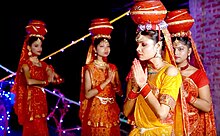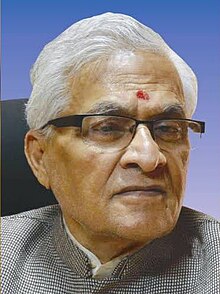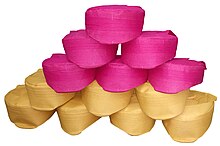Ethnic group
 Women performing Jhijhiya, the traditional dance of Mithila Women performing Jhijhiya, the traditional dance of Mithila | |
| Total population | |
|---|---|
| c. 70 million (est.) | |
| Languages | |
| Maithili Hindi and Nepali | |
| Religion | |
| Majority: Minority: | |
| Related ethnic groups | |
| Bengalis · Magahi · Bhojpuris |
Maithils (Devanagari: मैथिल), also known as Maithili people, are an Indo-Aryan cultural and ethno-linguistic group from the Indian subcontinent, who speak the Maithili language as their native language. They inhabit the Mithila region, which comprises Northern and Eastern Bihar and Northeastern Jharkhand in India & in Nepal constituting Madhesh Province in addition to some terai districts of Bagmati and Koshi Provinces.
The Mithila region forms an important part of Hinduism as it is said to be the birthplace of Sita, the wife of Ram and incarnation of Lakshmi.
History
Main article: History of Mithila RegionVedic period
See also: Videha, Vajjika League, and Licchavis of VaishaliMithila first gained prominence after being settled by Indo-Aryan speaking peoples who established the Videha kingdom. During the late Vedic period (c. 1100–500 BCE), Videha became one of the major political and cultural centers of South Asia, along with Kuru and Pañcāla. The kings of the Videha Kingdom were called Janakas.
The Videha Kingdom later became incorporated into the Vajjika League which was based in Vaishali. The Licchavis of Vaishali were one of the constituent tribes of the Vajjika league and the territory of the Licchavis formed a single territorial unit along with Videha and Mallakas. The Licchavis remained in Vaishali up to the Gupta period with the fourth century A.D. Gupta Emperor, Samudragupta, being the son of a Licchavi princess from Vaishali.
Medieval period
From the 11th century to the 20th century, Mithila was ruled by various indigenous dynasties. The first were the Karnatas of Mithila who ruled from 1097-1324 A.D. They were followed by the Oiniwar dynasty who ruled from 1325–1526 A.D.
During the Mughal-era, Mithila was controlled by a dynasty of zamindars called the Raj Darbhanga who were tributaries to the Mughals. It was during this period that the capital of Mithila was moved to Darbhanga.
Maithili-speaking dynasties and kingdoms
- Karnat dynasty, 1097 CE–1324 CE
- Oiniwar dynasty, 1325 CE–1526 CE
- Raj Darbhanga, 1557 CE −1947 CE
- Malla dynasty, 1201 CE-1779 CE
- Senas of Makwanpur, 1518 CE –1762 CE
Region
Main articles: Mithila (region); Mithila, India; and Mithila, NepalIndia

Majority of Maithils normally reside north of the Ganges; based around Darbhanga and the rest of North Bihar. Native Maithili speakers also reside in Delhi, Kolkata, Patna, Ranchi and Mumbai. There are almost 70 million Maithils in India.
Indian Mithila comprises Tirhut, Munger, Bhagalpur, Darbhanga, Kosi, and Purnia divisions of Bihar and Santhal Pargana division of Jharkhand.
- Darbhanga in particular played an important role in the history of Mithila and is considered one of its "core centers". It was the center of Raj Darbhanga who ruled most of the region.
- Madhubani also where Mithila painting originated from which is a major part of Maithili culture.
- Sitamarhi is claimed by many to be the birthplace of Goddess Sita with Sita Kund being a major pilgrimage site.
- Baliraajgadh, situated in present-day Madhubani district in Bihar is thought to be the capital of ancient Mithila Kingdom.
- Maithils played a major role in building the Baidyanath Temple which is an important pilgrimage site for them.
Nepal

The adjoining districts of the eastern Terai form Nepalese Mithila. This area was part of the kingdom of Videha. The kingdom appears in the Ramayana. Many people claim Janakpur to be the birthplace of Goddess Sita but this is disputed as many consider Sitamarhi as her birthplace.
There was a movement in the Madhesh region which is predominantly a Maithili community of Nepal for a separate province. Province No. 2 was established under the 2015 Constitution, which transformed Nepal into a Federal Democratic Republic, with a total of 7 provinces. Province No. 2 (now Madhesh Province) has a Maithili speaking majority and consists of most of the Maithili speaking areas of Nepal. It has been demanded by some Mithila activists that Province No. 2 be named 'Mithila Province'. Province no. 2 was given the name Madhesh Province on 17 January 2022.
Language

The common language of the Maithil people is Maithili, which is one of the recognised regional languages of India and the second national language of Nepal listed in the Eighth Schedule of the Indian Constitution and the Interim Constitution of Nepal. The Tirhuta script, also known as the Mithilakshar script and Kaithi script was used as the original script of the language. However, during the 20th century most Maithili writers gradually adopted Devanagari script for Maithili. Some traditional pandits still use Tirhuta script for pātā (ceremonial letters related to important functions, such as marriage).
Culture
Main article: Mithila cultureMen and women in Mithila are very religious and dress for festivals as well. The costumes of Mithila stem from the rich traditional culture of Mithila. Kurta and Dhoti with a Mithila Painting bordered Maroon coloured Gamchha which is the Symbol of Passion, Love, Bravery and Courage are common clothing items for men. Men wear a Gold ring on their nose which symbolizes prosperity, happiness and wealth inspired by Lord Vishnu. Also, wear a Balla on their wrist and Mithila Paag on their Head. In ancient times there was no colour option in Mithila, so the Maithil women wore white or yellow Saree with a red Border but now they have a lot of variety and colour options and wear Laal-Paara (the traditional red-boarded white or yellow Saree) on some special occasions, and also wear Shakha-Pola with a lanthi in their hand which is Mandatory to wear after marriage in Mithila. In Mithila culture, this represents new beginnings, passion and prosperity. Red also represents the Hindu goddess Durga, a symbol of new beginnings and feminine power. During Chhaith, the women of Mithila wear pure cotton dhoti without stitching which reflects the pure, traditional Culture of Mithila. Usually crafted from pure cotton for daily use and from pure silk for more glamorous occasions, traditional attire for the women of Mithila includes Jamdani, Banarisi, Bhagalpuri and many more. Many festivals are celebrated throughout the year in Mithila. Chhath Puja, Durga Puja and Kali puja is celebrated as perhaps the most important of all the celebrations of Mithila.

Household structure
Traditionally Maithils lived in Badaghars called longhouses with big families of many generations, sometimes 40–50 people. All household members pool their labour force, contribute their income, share the expenditure and use one kitchen.
Religion
The religious practices of the Maithils is based on orthodox Hinduism as Mithila has historically been a principal seat of Hindu learning. Apart from main stream Hinduism, there are some local traditions of worshiping Baraham Baba and Gosaun Devata by them. In every village of the Mithila region, there is at least one common worship place Brahma Sthan also known as Dihawar Sthan attached to an old pipal tree, where Brahma Baba is worshipped by the Maithils. Brahma Baba also called as Graama Devata is believed to be the protector God of the village. Similarly at every courtyards of the houses of Maithils, there is Gosaunik Ghar where Kuldevata of the family is worshipped.
Politics
Maithils hold significant influence in the politics of both India and Nepal. They dominate the polity of Bihar, India's third most populous state, by virtue of their majority in 144 of the 243 constituencies of the Bihar Legislative Assembly. Maithils are the largest ethnolinguistic group in the Nepalese Madhesh Province and the second largest ethnolinguistic group in Province No. 1.
Notable people
The following are notable residents (past and present) of Mithila region:
Historical


- Janaka, King of Mithila and Father in Law of King Rama.
- Sita, Princess of Mithila Kingdom and wife of King Rama.
- Udayanacharya, 10th/11th-century philosopher and logician of the Nyaya school.
- Vidyapati, 14th/15th century Maithili and Sanskrit poet-saint.
- Bhanudatta Misra, 15th/16th-century Sanskrit poet from Mithila.
- Harisimhadeva, King of Mithila during the Karnat dynasty from 1304 - 1324 CE.
- Gangadeva, King of Mithila during the Karnat dynasty from 1147-1187 CE.
- Narsimhadeva, King of Mithila during the Karnat dynasty from 1174-1227 CE.
- Ramasimhadeva, King of Mithila during the Karnat dynasty from 1227-1285 CE.
- Jyotirishwar Thakur, 14th-century poet, playwright and musician who composed the earliest prose work in the Maithili language, the Varna Ratnakara.
- Caṇḍeśvara Ṭhakkura, political theorist and general from the 14th century.
- Gaṅgeśa, 13th/14th century philosopher, logician and mathematician .
- Pakshadhara Mishra, 15th-century philosopher.
- Vāchaspati Misra, 9th/10th-century philosopher of the Advaita Vedanta tradition.
- Lakshmeshwar Singh, zamindar and principal landowner of Raj Darbhanga, 1860–1898.
- Rameshwar Singh, zamindar and principal landowner of Raj Darbhanga, 1898–1929.
- Śāriputra, 15th-century Indian Buddhist monk and the last abbot of the Mahabodhi Temple in Bodh Gaya. Born in Simraungadh in modern-day East Champaran district.
Modern
- Maghfoor Ahmad Ajazi, Indian Freedom fighter, political activist, social worker, poet and writer, born in Muzaffarpur
- Bimalendra Nidhi, Member of Nepalese parliament, Vice president of ruling party Nepali Congress and former Deputy Prime Minister of Nepal.
- Ramdhari Singh 'Dinkar' was an Indian Hindi poet, essayist, patriot and academic.
- Bindheshwari Prasad Mandal was an Indian parliamentarian and social reformer who served as the chairman of the Second Backward Classes Commission (popularly known as the Mandal Commission).
- C. K. Raut, formerly US-based computer scientist, author and political leader of Nepal.
- Syed Shahnawaz Hussain, Indian politician, born in Supaul
- Bhagwat Jha Azad was the Chief Minister of Bihar and a member of Lok Sabha.
- Ram Baran Yadav, First president of Nepal
- Tarkishore Prasad, Deputy Chief Minister of Bihar, born in Saharsa district
See also
- History of Mithila Region
- Culture of Mithila Region
- Maithili language
- Mithila
- Maithil cuisine
- Mithila State Movement
References
Notes
- "Demographics of Maithil population of Nepal".
- ^ Kumar Jha, Mithilesh (2017). Language Politics and Public Sphere in North India: Making of the Maithili Movement. Oxford University Press. pp. 37–45. ISBN 9780199091720.
- Burman, B.K.R.; Chakrabarti, S.B. (1988). Social Science and Social Concern: Felicitation Volume in Honour of Professor B.K. Roy Burman. Mittal Publications. p. 411. ISBN 9788170990628. Retrieved 14 February 2017.
- ^ Jha, Pankaj Kumar (2010). Sushasan Ke Aaine Mein Naya Bihar. Bihar (India): Prabhat Prakashan. ISBN 9789380186283.
- Brass, Paul R. (8 September 1994). The Politics of India Since Independence. Cambridge University Press. p. 184. ISBN 9780521459709. Retrieved 15 February 2017.
- Gellner, D.; Pfaff-Czarnecka, J.; Whelpton, J. (2012). Nationalism and Ethnicity in a Hindu Kingdom: The Politics and Culture of Contemporary Nepal. Taylor & Francis. p. 251. ISBN 9781136649561. Retrieved 14 February 2017.
- Minahan, J.B. (2012). Ethnic Groups of South Asia and the Pacific: An Encyclopedia: An Encyclopedia. ABC-CLIO. ISBN 9781598846607. Retrieved 14 February 2017.
- Michael Witzel (1989), Tracing the Vedic dialects in Dialectes dans les litteratures Indo-Aryennes ed. Caillat, Paris, pages 13, 141–143
- Raychaudhuri Hemchandra (1972), Political History of Ancient India, Calcutta: University of Calcutta, pp. 85–86
- Jha, Hit Narayan (1970). The Licchavis of Vaishali. Chowkhamba Sanskrit Series. pp. 14–15.
- Trautmann, Thomas (1972). "Licchavi-Dauhitra". The Journal of the Royal Asiatic Society of Great Britain and Ireland. 104 (1): 2–15. doi:10.1017/S0035869X0012951X. JSTOR 25203320.
- Jha, Makhan (1997). Anthropology of Ancient Hindu Kingdoms: A Study in Civilizational Perspective. M.D. Publications Pvt. ISBN 9788175330344. Retrieved 11 December 2016.
- Henning Brown, Carolyn (1988). "Raja and Rank in North Bihar". Modern Asian Studies. 22 (4): 757–782. doi:10.1017/S0026749X00015730. JSTOR 312524. S2CID 143084073.
- Mandal, R. B. (2010). Wetlands management in North Bihar. Concept Publishing Company. ISBN 9788180697074. Retrieved 14 December 2016.
- Jha, Makhan (1997). Anthropology of Ancient Hindu Kingdoms: A Study in Civilizational Perspective. M.D. Publications Pvt. ISBN 9788175330344. Retrieved 14 December 2016.
- Sinha, CPN (1969). "Origin of the Karnatas of Mithila – A Fresh Appraisal". Proceedings of the Indian History Congress. 31: 66–72. JSTOR 44138330.
- Pankaj Jha (20 November 2018). A Political History of Literature: Vidyapati and the Fifteenth Century. OUP India. ISBN 978-0-19-909535-3.
- Tahir Hussain Ansari (20 June 2019). Mughal Administration and the Zamindars of Bihar. Taylor & Francis. pp. 200–223. ISBN 978-1-00-065152-2.
- Brinkhaus, Horst (1991). "The Descent of the Nepalese Malla Dynasty as Reflected by Local Chroniclers". Journal of the American Oriental Society. 111 (1): 118–122. doi:10.2307/603754. JSTOR 603754.
- Das, Basudevlal (2013). "Maithili in Medieval Nepal : A Historical Apprisal". Academic Voices. 3: 1–3. doi:10.3126/av.v3i1.9704.
- Gellner, D (2012). Nationalism and Ethnicity in a Hindu Kingdom: The Politics and Culture of Contemporary Nepal. Routledge. p. 260. ISBN 978-1-136-64956-1.
- (India), Bihar; Choudhury, Pranab Chandra Roy (1957). "Bihar district gazetteers, Volume 17". p. 16. Retrieved 10 December 2016.
- Maithils at Ethnologue (16th ed., 2009) [REDACTED]
- "Maithils demanding a separate state in india".
- Jha, Makhan (1997). Anthropology of Ancient Hindu Kingdoms: A Study in Civilizational Perspective. M.D. Publications Pvt. p. 62. ISBN 9788175330344. Retrieved 10 December 2016.
- Madhubani paintings. Abhinav Publications. 2003. ISBN 9788170171560. Retrieved 10 December 2016.
- "नालंदा ने आनंदित किया लेकिन मिथिला के बलिराजगढ़ की कौन सुध लेगा ? – News of Bihar". NewsOfBihar.com. 16 July 2016. Archived from the original on 26 October 2017. Retrieved 26 October 2017.
- Narayan, Sachindra (1 June 1983). "Sacred Complexes of Deoghar and Rajgir". Concept Publishing Company – via Google Books.
- Kumāra, Braja Bihārī (1998). Small States Syndrome in India. Concept Publishing Company. p. 146. ISBN 9788170226918. Archived from the original on 17 February 2017. Retrieved 16 February 2017.
- Bolduc, Benjamin; Hodgkins, Suzanne B.; Varner, Ruth K.; Crill, Patrick M.; McCalley, Carmody K.; Chanton, Jeffrey P.; Tyson, Gene W.; Riley, William J.; Palace, Michael; Duhaime, Melissa B.; Hough, Moira A.; Saleska, Scott R.; Sullivan, Matthew B.; Rich, Virginia I. (13 August 2020). "Supplemental Information 3: An excerpt from Data Downloads page, where users can download original datasets". PeerJ. 8: e9467. doi:10.7717/peerj.9467/supp-3.
- Michael Witzel (1989), Tracing the Vedic dialects in Dialectes dans les litteratures Indo-Aryennes ed. Caillat, Paris, pages 13, 17 116–124, 141–143
- Gellner, D.; Pfaff-Czarnecka, J.; Whelpton, J. (6 December 2012). Nationalism and Ethnicity in a Hindu Kingdom. Routledge. ISBN 9781136649561. Retrieved 8 December 2016.
- Burkert, C. (2012). "Defining Maithil Identity". In Gellner, D.; Pfaff-Czarnecka, J.; Whelpton, J. (eds.). Nationalism and Ethnicity in a Hindu Kingdom: The Politics and Culture of Contemporary Nepal. London, New York: Routledge. pp. 241–273. ISBN 9781136649561. Archived from the original on 20 August 2017.
- "Samiti vows to protest for Mithila Province".
- "Province 2 endorses Madhes as its name, Janakpurdham as provincial capital". kathmandupost.com. Retrieved 2022-04-28.
- Jyotiśvara. (1998). Varṇa-ratnākara of Jyotiriśvara of Kaviśekharācārya. New Delhi: Sahitya Akademi. pp. ix. ISBN 81-260-0439-8. OCLC 40268712.
- Chaudhary, Pranava (May 22, 2011). "US scholar's project of encoding Tirhuta script into digital media". The Times of India. Archived from the original on April 5, 2012. Retrieved 26 July 2013.
- Maithil women wore Red Boarded Yellow or White Saree during Jhijhiya Naach. Retrieved 27 March 2017.
- "Mithila as well as Bengal wearing शाखा पोला" www.jhajistore.com". Retrieved 12 August 2019.
- Lam, L. M. (2009). "Park, hill migration and changes in household livelihood systems of Maithils in Central Nepal" (PDF). University of Adelaide. Archived from the original (PDF) on 2011-09-28.
- Vidyabhusana, Satis Chandra (1988). A History of Indian Logic: Ancient, Mediaeval and Modern Schools. Motilal Banarsidass Publishers. ISBN 9788120805651. Retrieved 8 December 2016.
- "मिथिलाक लोक देवता डिहवार ,ब्रह्मबाबा". Maithil Manch. Retrieved 2024-11-18.
- Chaudhary, Radhakrishna. Mithilak Itihas (in Hindi). Ram Vilas Sahu. p. 212. ISBN 978-93-80538-28-0.
- "Official status sought for Maithili in Province 2". 26 December 2017.
- Ministry of Culture, Government of India. "Maghfoor Ahmad Ajazi". amritmahotsav.nic.in.
- Sajjad, Mohammad (6 January 2013). "Maghfur Aijazi: A freedom-fighter and a builder of Indian democracy". TwoCircles.net. Retrieved 5 March 2015.
- "Nidhi appointed NC Vice-Prez, Khadka Gen Secy". kathmandupost.com. Retrieved 2022-01-15.
- "Ramdhari Singh Dinker - Hindi ke Chhayavadi Kavi". www.anubhuti-hindi.org. Retrieved 2020-04-26.
- Nitish Kumar and the Rise of Bihar. Penguin Books India. 2011-01-01. ISBN 9780670084593.
- "" मुख्य समाचार " :: नेपाल ::". Ekantipur.com. 24 May 2015. Archived from the original on 4 July 2015. Retrieved 28 May 2015.
- IANS (10 December 2013). "BJP's Shahnawaz Hussain on IM hit list". Business Standard India. Archived from the original on 26 October 2017. Retrieved 26 October 2017 – via Business Standard.
- "BJP leader Shahnawaz Hussain's impersonator arrested". NDTV.com. Archived from the original on 19 December 2013. Retrieved 26 October 2017.
- "PM's 'lack' of leadership has made UPA 'sinking ship': BJP". NewIndianExpress.com. Archived from the original on 4 March 2016. Retrieved 26 October 2017.
- "8th Lok Sabha – Members Bioprofile – AZAD, SHRI BHAGWAT JHA". Archived from the original on 6 October 2011. Retrieved 6 August 2011.
- "I want self-reliant Bihar; Sushil Modi is our guardian, says new deputy CM Tarkishore Prasad". 19 November 2020.
Bibliography
- Alan R. Beals & John Thayer Hitchcock (1960). "Field Guide to India". India: National Academies.